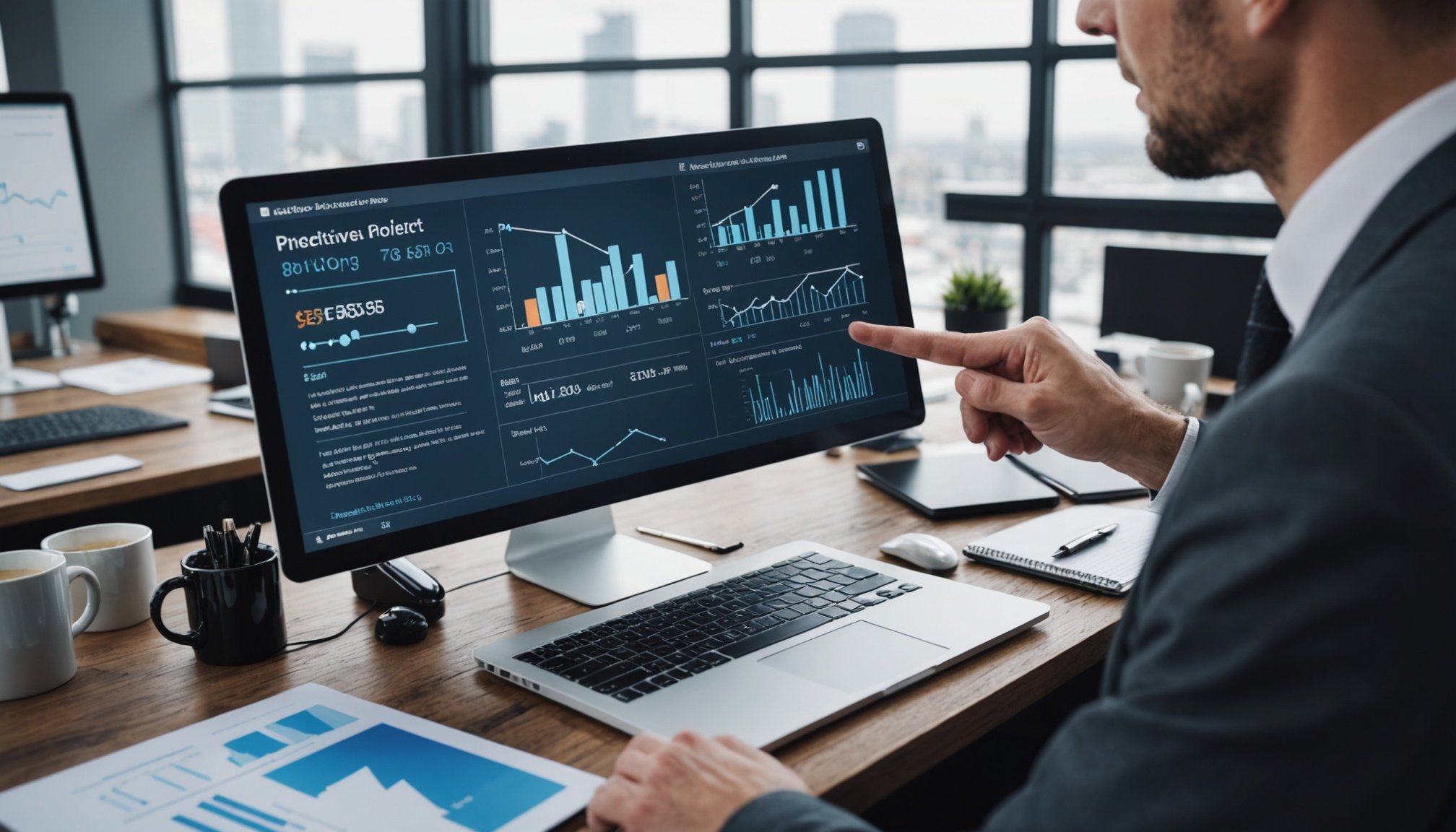Unlocking Sales Potential: How UK Businesses Can Use Predictive Analytics to Elevate Sales Forecasting Precision
In the ever-evolving landscape of business, precision in sales forecasting is crucial for maintaining a competitive edge. For UK businesses, leveraging predictive analytics can be a game-changer, enabling them to make informed decisions, optimize resources, and ultimately drive growth. Here’s a comprehensive guide on how predictive analytics can elevate sales forecasting precision.
The Basics of Predictive Analytics
Predictive analytics is a branch of advanced analytics that uses statistical techniques and machine learning to predict future events. It involves learning patterns from historical data to anticipate outcomes, helping businesses make proactive decisions. At its core, predictive analytics utilizes data mining techniques, mathematical algorithms, and machine learning models to generate insights from existing data[1].
Also read : Boosting customer delight: creative strategies for uk retailers to harness chatbots effectively
For businesses, predictive analytics is not just about crunching numbers; it’s about understanding and deploying models to transform raw data into meaningful forecasts that guide strategic decision-making. Here are the key processes involved:
Data Collection
Data collection involves gathering data points that might indicate future behaviors or outcomes. These could include customer purchase histories, product performance metrics, or other business-specific data streams.
Topic to read : Boosting customer delight: creative strategies for uk retailers to harness chatbots effectively
Data Interpretation
Data interpretation is about recognizing patterns and relationships within that data, often requiring the analyst to apply a combination of domain knowledge and statistical skills.
Key Applications of Predictive Analytics in Sales Forecasting
Predictive analytics has numerous applications that can significantly enhance sales forecasting precision.
Marketing and Sales
Predictive analytics can be used to predict which products a customer is likely to buy, enabling personalized recommendations and targeted marketing campaigns. For instance, Netflix uses predictive models to recommend movies based on viewing history, and retailers like Tesco predict which discounts will be redeemed at checkout to optimize coupon distribution[1].
Example: Personalized Marketing
A retail business can use predictive analytics to analyze customer behavior and purchase history. By identifying trends, the business can create personalized marketing campaigns that are more likely to convert. For example, if a customer frequently buys winter clothing during the autumn season, the business can send targeted promotions and discounts on winter apparel just before the season starts.
Risk Management and Demand Planning
Predictive models can help identify potential risks and demand fluctuations, allowing businesses to adjust their strategies accordingly. In the context of sales forecasting, this means predicting sales revenue changes based on various factors such as market trends, competitor activities, and external variables like weather and economic conditions[2].
Example: Sales Forecasting with External Variables
A company selling ice cream can use predictive analytics to forecast demand based on historical sales data and external factors like weather forecasts. If a heatwave is predicted, the company can anticipate a peak in demand and adjust inventory and production accordingly[5].
The Predictive Analytics Process in Sales Forecasting
The process of using predictive analytics for sales forecasting involves several steps:
Data Collection and Integration
This step involves gathering data from various sources such as historical sales, customer behavior, market trends, and real-time data streams. The data is then cleansed, filtered, and standardized to ensure accuracy[3].
Model Development
Statistical and machine learning algorithms such as ARIMA, LSTM, and regression models are used to analyze the relationship between demand and various influencing factors. Clustering and classification techniques segment customer preferences and buying patterns, aiding in targeted demand forecasting[3].
Deployment
The predictive model is deployed into the production environment, where it can start generating predictions based on real-time data. This involves integrating the model with existing systems, ensuring it is accessible and easy for stakeholders to use[1].
Monitoring and Optimization
The model’s performance is regularly monitored as data and trends evolve over time. It’s essential to periodically update and retrain the model to maintain its accuracy and relevance[1].
Key Concepts in Predictive Modeling for Sales Forecasting
Understanding predictive modeling techniques is vital for business analysts. Here are some key concepts:
Machine Learning Algorithms
Machine learning algorithms can analyze enormous volumes of sales data and identify trends that might go unseen by the human eye. These algorithms can also factor in external variables such as weather forecasts and market indicators to make better predictions[4].
Real-Time Forecasting
Machine learning algorithms can adapt to data in real time, allowing businesses to make decisions based on the latest information. This is particularly useful in industries where conditions change rapidly, such as retail or financial services[2].
Scenario Planning and Simulation
Businesses can create dynamic plans that adapt to changing conditions by simulating different scenarios. For example, “What will happen if we increase marketing spend by 10%?” or “How will sales forecasts change if we adjust pricing strategies?” By running “what-if” simulations, businesses can make informed decisions and proactively plan for future success[2].
Benefits of Predictive Analytics in Sales Forecasting
The use of predictive analytics in sales forecasting offers several benefits:
Enhanced Accuracy in Demand Prediction
Predictive analytics brings greater accuracy by integrating real-time and external data, capturing demand fluctuations more effectively. This reduces the risk of overstocking or understocking and minimizes inventory holding costs[3].
Reduced Operational Costs
By preventing overstocking and understocking, predictive analytics minimizes inventory holding costs and reduces wastage, especially for perishable goods. Additionally, route optimization and labor management lead to savings in fuel, storage, and labor costs[3].
Improved Customer Satisfaction
When businesses can accurately forecast demand and deliver orders on time, customer satisfaction increases. Predictive analytics allows companies to anticipate and fulfill customer expectations by ensuring timely delivery and product availability[3].
Practical Tips for UK Businesses
Here are some practical tips for UK businesses looking to use predictive analytics to elevate their sales forecasting precision:
Track Seasonal Sales Trends
Track seasonal sales trends to anticipate fluctuations. For example, a business selling winter clothing should anticipate higher demand during the autumn season and adjust inventory accordingly[4].
Use Customer Insights
Use customer insights to tailor product or service offerings. By analyzing customer behavior and preferences, businesses can create personalized marketing campaigns that are more likely to convert[4].
Leverage AI Tools
Leverage AI tools that save time and drive efficiencies. AI tools can analyze enormous volumes of sales data and identify trends that might go unseen by the human eye[4].
Align Budgets with Data-Backed Forecasts
Align budgets with data-backed forecasts to control costs. Accurate predictions enable companies to better manage inventory, prepare effective budgets, and focus on sales efforts with higher potential[4].
Real-World Examples and Case Studies
Example: Hewlett-Packard (HP)
Hewlett-Packard (HP) uses predictive analytics to assess the likelihood of an employee leaving, enabling managers to take preventive actions to retain key talent. This approach can also be applied to sales forecasting by predicting customer churn and implementing targeted retention strategies[1].
Example: Con Edison
Con Edison uses predictive analytics to predict system failures in high-consumption scenarios, optimizing supply chain logistics and reducing operational costs. Similarly, businesses can predict demand spikes and adjust inventory levels accordingly[1].
Table: Comparing Traditional vs. Predictive Analytics in Sales Forecasting
| Aspect | Traditional Analytics | Predictive Analytics |
|---|---|---|
| Data Sources | Historical sales data only | Historical sales data, customer behavior, market trends, real-time data streams |
| Accuracy | Limited by historical data | Enhanced by integrating real-time and external data |
| Decision Making | Reactive | Proactive |
| Cost Efficiency | Higher inventory holding costs | Reduced inventory holding costs and wastage |
| Customer Satisfaction | Lower due to stockouts or overstocking | Higher due to timely delivery and product availability |
| Scalability | Limited by data volume | Scalable with cloud infrastructure |
| Real-Time Capabilities | No real-time forecasting | Real-time forecasting and adaptation |
Quotes and Insights from Experts
- “Success is not a random act. It arises out of a predictable and powerful set of circumstances and opportunities.” – Malcolm Gladwell[4]
- “A forecast is, by its very nature, wrong. Nobody can predict the future.” – Assâad Moumen, highlighting the importance of continuous model optimization[5]
- “Predictive analytics analyses seasonal sales fluctuations, evaluating the impact of past marketing campaigns and tracking changes in customer behavior.” – Peter Harris, COO, Pipedrive, on the role of predictive analytics in sales planning[4]
Predictive analytics is a powerful tool that UK businesses can use to elevate their sales forecasting precision. By leveraging historical data, real-time data streams, and external variables, businesses can make informed decisions, optimize resources, and drive growth. Whether it’s through personalized marketing campaigns, demand planning, or inventory management, predictive analytics offers a myriad of benefits that can transform the way businesses operate.
In a world where change is the only constant, predictive analytics provides the crystal ball that businesses need to navigate the future with confidence. By embracing this technology, UK businesses can stay ahead of the curve, enhance customer satisfaction, and achieve sustainable growth in an ever-evolving market.




